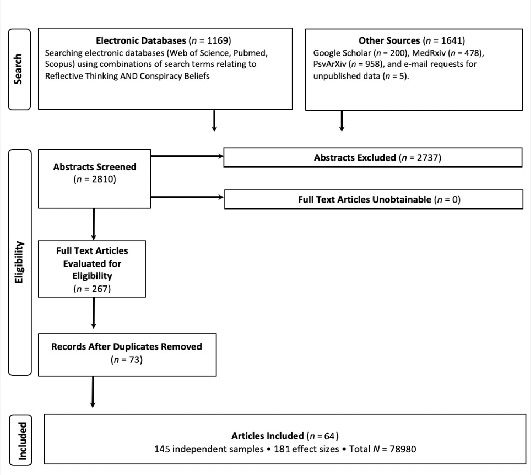
| Figure 1: PRISMA flowchart of the selection process. |
Judgment and Decision Making, Vol. 17, No. 4, July 2022, pp. 720-744
Reflective thinking predicts lower conspiracy beliefs: A meta-analysisBüşra Elif Yelbuz* Ecesu Madan# Sinan Alper$ |
Abstract: One of the many established predictors of conspiracy beliefs is reflective thinking, but no meta-analysis so far has examined this relationship. In the current meta-analysis of published and unpublished correlational data (145 samples, 181 effect sizes), we found a significant negative association between reflective thinking and conspiracy beliefs with a medium-level effect size (r = –.189) . Similar levels of correlations were found across different types of measures (self-report vs. performance-based) and conspiracy beliefs (generic vs. specific). Further, no evidence suggested publication bias in this body of work. Suggestions for future research are discussed.
Keywords: analytical, conspiracy, intuitive, meta-analysis, reflective
Belief in conspiracy theories, alternative explanations for important events that assume the existence of secret plots by powerful and malicious groups (e.g., Goertzel, 1994), have been a common encounter in our social lives for quite some time. For instance, in 2013, it was found that over a third of Americans did not believe that global warming was real (Swift, 2013). Yet, especially with the rise of the COVID-19 pandemic, discussions concerning conspiracy beliefs have become even more prevalent, among psychology researchers as well as laypeople. Growing effort has been put into trying to uncover the psychological mechanisms underlying such beliefs, and rightly so. Belief in conspiracy theories can have far reaching negative consequences for society as a whole as well as for the individual believer (Allington et al., 2020; Douglas & Sutton, 2015; Jolley et al., 2019; Jolley et al., 2020), such as reducing willingness to vaccinate against serious diseases and viruses (Bertin et al., 2020; Romer & Jamieson, 2020).
Researchers have revealed several predictors of conspiracy beliefs (van Mulukom et al., 2022). From the personality literature, it is evident that demographic variables such as age (Pizarro et al., 2020; Juanchich et al., 2021), personality traits (Bowes et al., 2020; March & Springer, 2019), and how one reacts to threat and uncertainty (Heiss et al., 2021) influence conspiracy beliefs. From the social domain, although less attended to, research has pointed towards the importance of social context (Alper, 2021; van Prooijen & van Lange, 2014), normative influence (Cookson et al., 2021) and group membership (Cookson et al., 2021a,b; Imhoff & Bruder, 2014). From the cognitive domain, and the focus of this meta-analysis, ample evidence now indicates that reasoning processes and biases such as an individual’s tendency to think reflectively can predict their tendency to believe in conspiracy theories (e.g., Alper et al., 2021; Mikušková, 2017; Pytlik et al., 2020; Ståhl & van Prooijen, 2018; Swami et al., 2014). Many studies show that individuals who think reflectively (i.e., analytically, deliberately) are less inclined to believe in conspiracy theories compared to individuals who think intuitively (i.e., experientially), showing that cognitive reflection can act as a buffer against conspiracy beliefs (e.g., Alper et el., 2021; Mikušková, 2017; Pytlik et al., 2020; Ståhl & Van Prooijen, 2018; Swami et al., 2014). However, to date, there has been no attempt to systematically review, meta-analyze or test the probability of publication bias in this body of work. The current meta-analysis aims to address this gap.
The link between reflective thinking and conspiracy beliefs has been tested in a variety of ways, though mainly via correlational methods. Regarding the assessment of conspiracy beliefs, researchers have applied both generic, such as the ‘Generic Conspiracy Beliefs Scale’ (GCBS; Brotherton et al., 2013), which capture individuals’ generalized tendency toward conspiracy theorizing and more specific measures, such as the ‘Belief in Vaccine Conspiracy Theories Scale’ (VCBS; Shapiro et al., 2016), which capture belief in a specific set of conspiracy theories. Notably, this body of work has conceptualized reflective thinking in many different ways, typically addressing it as either reflective (Sadeghiyeh et al., 2020), analytic thinking (Swami & Barron, 2021; Stanley et al., 2021), rational thinking (Georgiou et al., 2019) or critical thinking (Lantian et al., 2021). However, they all refer to the same sort of underlying construct, namely, the tendency to engage in reflective and deliberative thought processes as opposed to more automatic and intuitive thought processes (Frederick, 2005; Evans & Stanovich, 2013). For the purpose of uniformity, we refer to this construct as reflective thinking throughout this paper.
In terms of operationalizing reflective thinking, correlational studies have mainly preferred one of two ways – applying either performance-based or self-report measures. The most typical performance-based measures is the Cognitive Reflection Test (CRT; Frederick, 2005). In this test individuals are presented with three different problems. Importantly, there is both an intuitive (low effort) and an analytic (high effort) answer to each problem. For example, for the problem “A bat and a ball cost $1.10. The bat costs $1.00 more than the ball. How much does the ball cost?”, the intuitive answer occurring to many people would be 10 cents. However, through reflection, it can be calculated that the correct answer is actually 5 cents. Thus, higher scores on the CRT capture an individual’s tendency toward reflection, whereas lower scores capture the tendency to think intuitively. Different variations of the CRT have been applied (Thomson & Oppenheimer, 2016; Primi et al., 2016), but importantly, a recurring finding in the literature is that higher scores on the CRT are associated with lower conspiracy beliefs (Adam-Troian et al., 2019; Alper et al., 2021; Sanchez & Dunning, 2021; van Bavel et al., 2022; Wagner-Egger et al., 2018). This has been the case for both generic and specific conspiracy beliefs. For example, Sire et al. (2018) found that participants who reported more correct responses on the CRT (i.e., thought reflectively) reported lower conspiracy mentality and Stanley et al. (2021) as well as Erceg et a.l (2020) found that higher scores on the CRT were negatively associated with belief in COVID-19 conspiracy theories. Nevertheless, there are also some findings of no significant relationship between scores on the CRT and generic (Ståhl & van Prooijen, 2018) or specific (van Proojen et al., 2022) conspiracy beliefs.
The most commonly used self-report measures consist of variations of the Rational-Experiential Inventory (REI; Epstein et al., 1996) such as the REIm (Norris & Epstein, 2011) or REI-40 (Pacini & Epstein, 1999). Typically, all versions of this scale contain two subscales that capture individuals’ preference for reflective (i.e., rational) and intuitive (i.e., experiential) thinking. Importantly, many studies report a significant negative relationship between scores on the reflective thinking subscale and conspiracy beliefs (Swami et al., 2014; Gligorić et al., 2018; 2021), and a positive relationship between scores on the intuitive thinking subscale and conspiracy beliefs (Erceg et al., 2020; Fuhrer & Cova, 2020; Gligorić et al., 2018; 2021; Swami et al., 2014). These findings once again extend to both generic and specific conspiracy beliefs. For example, Georgiou et al. (2019) found that scores on the reflective thinking subscale were significantly and negatively related to generic conspiracy beliefs and, compatibly, Alper et al. (2021) found that scores on the intuitive thinking subscale were positively related to generic conspiracy beliefs. Further, Pytlik et al. (2020) and Tomljenovic et al. (2020) reported findings of a positive relationship between specific sets of conspiracy theories, such as belief in vaccine conspiracy theories, and scores on the intuitive sub scale. Nevertheless, there are also reports of null findings in the literature, for instance Libretto et al. (2020) did not find any evidence for a significant relationship between generic conspiracy beliefs and the rational or intuitive subscale, though their sample size was low compared to other similar studies.
With growing interest in conspiracy beliefs, the number of studies and, consequently, the number of systematic reviews and meta-analyses in this field have risen in the last few years. Some researchers have systematically reviewed the conspiracy beliefs literature as a whole, attempting to provide a more general state of the art (Douglas et al., 2017; 2019; Goreis & Voracek, 2019; van Prooijen & van Vugt, 2018) or focused on findings regarding a specific set of conspiracy beliefs (van Mulukom et al., 2022). Others, such as Stojanov and Halberstadt (2020) who meta-analyzed the overall effect of lack of control on conspiracy beliefs, have taken more specific findings under the microscope. Yet we know of no effort to systematically review or meta-analyze the currently available evidence. Thus, we conducted a meta-analysis to address the following objectives: (1) identify correlational research that investigates conspiracy beliefs in relation to reflective thinking; (2) identify the different ways in which reflective thinking has been operationalized and measured with respect to conspiracy beliefs; (3) generate a narrative summary of the key findings; (4) assess the risk of publication bias in this work; and overall, (6) summarize findings on the correlational relationship between reflective thinking and conspiracy beliefs, while also providing directions for future research.
The literature search was conducted in February and March 2022. As previously recommended (Card, 2015), both discipline-specific databases (Pubmed) and larger, cross-disciplinary databases (Web of Science, Scopus and Google Scholar) were screened. Notably, regarding our searches on Google Scholar, due to the excessive number of results (N = 101000), only the most relevant first 200 articles were screened as previously suggested by Haddaway et al. (2015). The following keywords were used in our search strategy: (conspirac*) AND (rational* OR reflecti* OR intuiti* OR deliberat* OR fast OR slow OR automatic OR system 1 OR system 2 OR thinking style OR bias). Additionally, in order to include unpublished work as well, we screened preprint databases (PsyArXiv and MedRxiv) and sent out an open call for unpublished data via email to all corresponding authors of articles that test the relationship between reflective thinking and conspiracy beliefs. The search log used to record and keep track of all database searches and can be found at OSF (https://osf.io/2jvc3/?view_only=113f7ab290a1415ba9991f65b8b87f1b ). To be included in the meta-analysis articles had to contain (1) a quantitative design that statistically tested the correlational relationship between reflective thinking and conspiracy beliefs, (2) a measure and/or manipulation of reflective thinking, (3) a scale measure of conspiracy beliefs, (4) enough information to extract or calculate effect size (e.g., Pearson’s r) and (5) English as the language of publication.
The search resulted in a total of 2810 records. Figure 1 shows a PRISMA flowchart of the selection process (Moher et al., 2009). Reviewers (first and second author) firstly screened the titles and abstracts of all collected records. If the article appeared to be relevant, we then assessed the full-text to ensure that it met the inclusion criteria outlined above. This resulted in a total of 267 articles, which then dropped down to 68 after the removal of duplicates. Further, 5 unpublished studies were sent in response to our open call, to which approximately 45% of the contacted authors responded to (regardless of whether they had available data or not). Thus, this left a total of 73 studies and 161 studies to be considered with more scrutiny for a final decision on inclusion in the meta-analysis. In cases where consensus could not be reached between the two reviewers about a paper’s eligibility, the third reviewer (senior author) made a final decision. For studies with overlapping data, to avoid using the same data multiple times, simply one study per data set was included in the analysis.

Figure 1: PRISMA flowchart of the selection process.
Based on this search strategy, in our final analysis, we included 64 articles (48 published, 16 unpublished), which contained 145 studies (122 published, 23 unpublished) and 181 effect sizes. The data points extracted from these articles were compiled onto a Google spreadsheet (including article characteristics, study characteristics, sample characteristics, analysis characteristics and findings), which can be found on OSF (https://osf.io/bxknp?view_only=113f7ab290a1415ba9991f65b8b87f1b).
To prepare the data for analysis, certain modifications and categorizations were applied to the original dataset. Firstly, the studies were coded based on whether they were published or not (yes vs. no) and, where applicable, the samples’ corruption perceptions index (see Supplemental Materials) was added as a new variable to the data set. Secondly, the effect sizes of correlational studies which reported Spearman’s rank correlation coefficients were transformed to Pearson’s r correlation coefficients using the guidelines recommended by Rupinski and Dunlap (1996) in order to have a common metric. Next, all the available effect sizes were coded as belonging to one of four categories (where “CB” means “conspiracy beliefs” and “RT” means “rational thinking”): (1) Generic CB, Self-Report RT; (2) Generic CB, Performance-Based RT; (3) Specific CB, Self-Report RT; (4) Specific CB, Performance-Based RT. This was done so that, in addition to looking at the overall meta-analytic correlation, we could also meta-analyze the bulk of studies which used self-report RT measures separately from the ones that used performance-based RT measures, while also separating generic and specific conspiracy belief findings. Finally, two separate datasets were prepared: (1) A weaker estimates dataset and (2) a stronger estimates dataset. Namely, for articles which contained multiple effect sizes in a single study, with more than one effect size that fit into one of our four variable categories mentioned above, the weaker effect size was entered into the weaker estimates dataset (i.e., the main analyses dataset) while the stronger effect size was entered into the stronger estimates dataset. Here we report our meta-analysis findings with respect to the weaker estimates, however, data regarding the stronger estimates can be found in the Supplemental Materials
Jamovi’s meta-analysis module ‘MAJOR’ (Hamilton, 2018; version 1.2.0), which is based on the metafor package designed for R (Viechtbauer, 2010), was used for our random-effects meta-analysis. The model estimator was restricted maximum-likelihood and model measures were transformed using Fisher’s r-to-z transformation. Further, the risk of publication bias, the tendency to omit non-significant results and publish only positive results, was examined in two steps. Firstly, a visual assessment using the funnel plot method (Egger et al. 1997) was conducted, which was followed by a rank correlation test (Begg & Mazumdar, 1994) and a regression test (Egger et al., 1997). Secondly, p-curve analysis (Simonsohn et al., 2014) was carried out, using the built-in application available in MAJOR module (Hamilton, 2018). Our study was pre-registered prior to data collection (https://osf.io/ngxyu/?view_only=fbcc0c15e89f4286bbb7cb469657fc3a).
The meta-analysis of 145 independent samples yielded a meta-analytic correlation of r = –.189, SE = .008, z = –22.308, p < .001, 95% CI [–.206, –.172].1 94% of all estimates were negative, indicating a clear negative correlation between reflective thinking and conspiracy beliefs (Figure 2). Egger’s regression test, value = 2.074, p = .038, but not the rank correlation test, value = .080 p = .155, indicated a funnel plot asymmetry (Figure 3). Note that the asymmetry is opposite to the direction implied by publication bias: the low-powered studies show reduced effects (i.e., lower or positive correlations). The p-curve analysis (Figure 4) provided strong support for a true effect with a right-skewed distribution of p values. When publication status (yes vs. no) was added to the meta-regression as a categorical moderator, it had no significant association, b = .022, SE = .023, p = .353, 95% CI [–.024, .067], which further suggests that there is no publication bias2
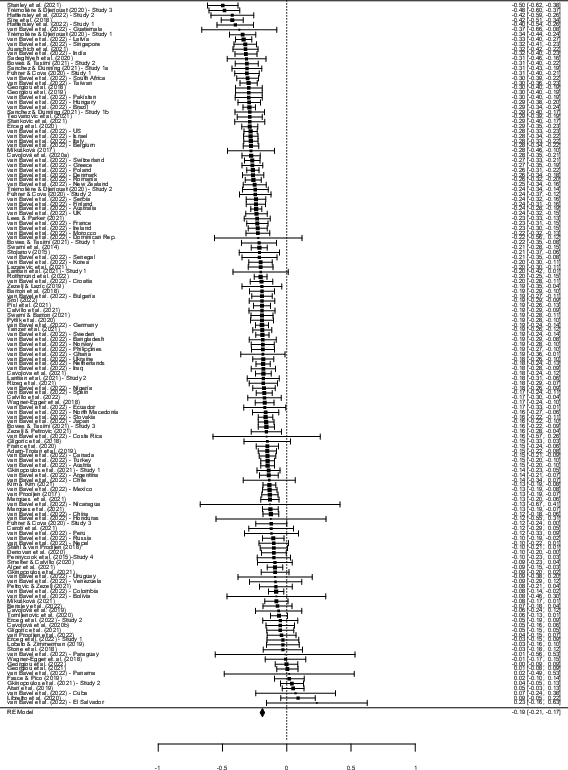
Figure 2: Forest plot showing the observed correlations between reflective thinking and conspiracy beliefs. Bars represent 95% confidence intervals. Studies are ranked from the strongest negative to strongest positive correlation. A higher resolution version of the plot is available at https://osf.io/7ejba/?view_only=113f7ab290a1415ba9991f65b8b87f1b.
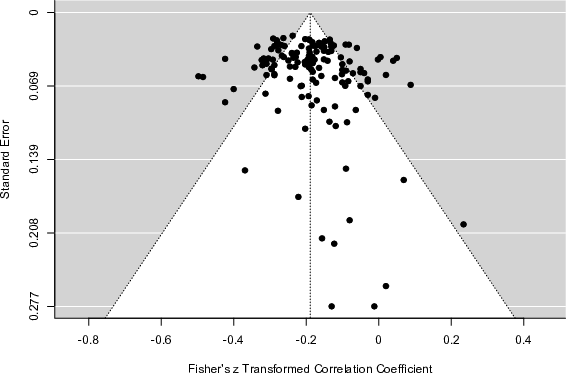
Figure 3: Funnel plot showing the distribution of associations between reflective thinking and conspiracy beliefs in correlational studies that were published.
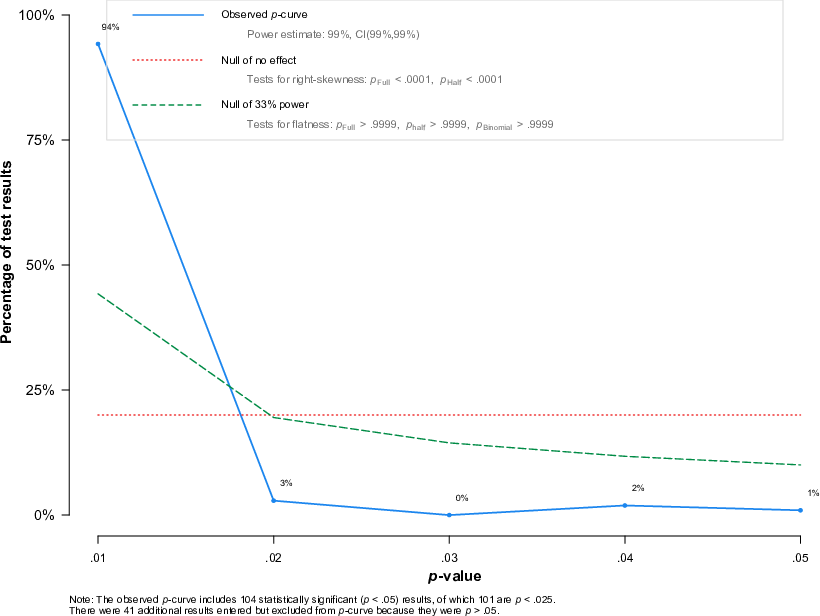
Figure 4: p-curve plot showing the distribution of p-values in the published research on the correlation between reflective thinking and conspiracy beliefs. The right-skewed shape suggests that there is no publication bias.
When only self-report measures were included, reflective thinking had a significant negative association with generic (k = 28), r = –.173, SE = .035, z = –4.986, p < .001, 95% CI [–.241, –.105] (Figure 5), and specific conspiracy beliefs (k = 23), r = –.146, SE = .025, z = –5.776, p < .001, 95% CI [–.196, –.097] (Figure 6).
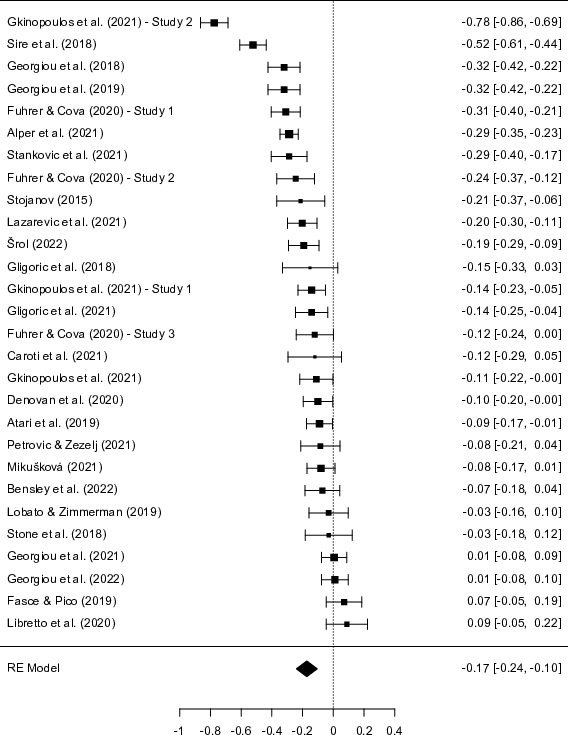
Figure 5: Forest plot showing the observed correlations between self-report measures reflective thinking and generic conspiracy beliefs. Bars represent 95% confidence intervals. Studies are ranked from the strongest negative to strongest positive correlation.
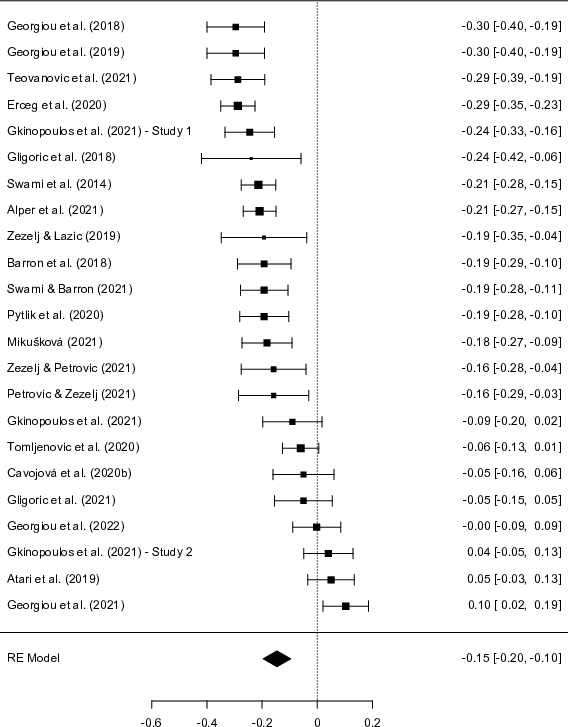
Figure 6: Forest plot showing the observed correlations between self-report measures reflective thinking and specific conspiracy beliefs. Bars represent 95% confidence intervals. Studies are ranked from the strongest negative to strongest positive correlation.
When only performance-based measures (e.g., CRT) were included, reflective thinking had a significant negative association with generic (k = 33), r = –.175, SE = .016, z = -10.943 p < .001, 95% CI [–.207, –.144] (Figure 7), and specific conspiracy beliefs (k = 94), r = –.219, SE = .009, z = -24.646, p < .001, 95% CI [–.236, –.201] (Figure 8).
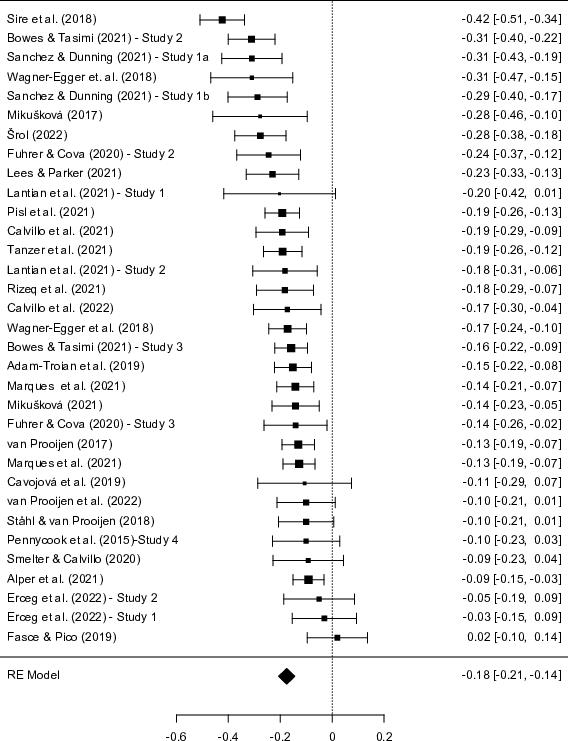
Figure 7: Forest plot showing the observed correlations between performance-based measures reflective thinking and generic conspiracy beliefs. Bars represent 95% confidence intervals. Studies are ranked from the strongest negative to strongest positive correlation.
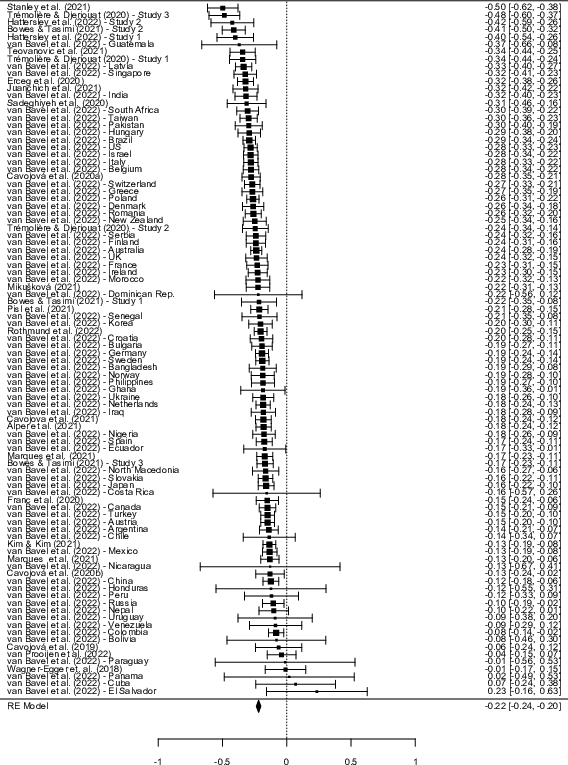
Figure 8: Forest plot showing the observed correlations between performance-based measures reflective thinking and specific conspiracy beliefs. Bars represent 95% confidence intervals. Studies are ranked from the strongest negative to strongest positive correlation.
The meta-analysis of correlational research suggested a significant negative association between reflective thinking and conspiracy beliefs at r = –.189, which is close to the benchmark of medium effect size, r = .20, in psychological science (Funder & Ozer, 2019). Thus, we conclude that reflective thinking negative predicts conspiracy beliefs and the size of this association is sufficient even for practical use in the short run (see Funder & Ozer, 2019). Considering r = –.189, a two-tailed alpha of .05, and a power of 90%, future studies should aim to recruit a minimum of 290 participants to detect a significant correlation between reflective thinking and conspiracy beliefs (Faul et al., 2009).
This meta-analysis provides empirical and systematic insight to the question: What is the relationship between reflective thinking and conspiracy beliefs? Our analysis of correlational research conducted to date reveals a significant negative association between reflective thinking and conspiracy beliefs at r = –.189, not far from what is considered to be the benchmark of a medium effect size in psychological science (r = .20; Funder & Ozer, 2019). Remarkably, risk of bias assessment via the funnel plot method (Egger et al. 1997) and p-curve analysis (Simonsohn et al., 2014) jointly suggests that there is no publication bias in this body of work. Thus, there is sufficient evidence indicating that reflective thinking is a negative predictor of belief in conspiracy theories and that it can be put to practical use to protect individuals from the potentially detrimental outcomes of conspiracy beliefs (Bertin et al., 2020).
Regarding the measurement of reflective thinking, despite previous research suggesting that the CRT is rather a cognitive ability test rather than a measure of reflective thinking disposition (Otero et al., 2022), we find that both performance based measures (mainly consisting of the CRT) and self-report measures were significant predictors of individuals’ belief in conspiracy theories. Namely, we found that both performance-based (r = –.175) and self-report measures (r = –.173) were significantly and negatively associated with generic conspiracy beliefs. Regarding specific conspiracy beliefs, again, we found that both performance-based measures (r = –.219) and self-report measures (r = –.146) were significantly and negatively associated with such beliefs.
Why does reflective thinking predict conspiracy beliefs? It is possible that reflectively processing information inhibits individuals’ intuitions and biases that support the acceptance of conspiracy beliefs while also increasing attention to detect the logical fallacies inherent in most conspiracy theories (Brotherton & French, 2013; Swami et al., 2014; van Prooijen & van Vugt, 2018). Further, reflective thinking may equip individuals with the space and skills to override and deliberately evaluate any pre-existing conspiracy beliefs (Swami et al., 2014; Douglas et al., 2019). It could also be the case that conspiracy theories attract an intuitive thinking style simply due to their nature of typically requiring lower cognitive effort and triggering affective feelings (Swami et al., 2014; Swami & Furnham, 2014; van Prooijen & van Vugt, 2018). Finally, it is possible that these findings demonstrate a broader function of reflective thinking, namely, that it fosters skepticism towards any sort of epistemically suspect beliefs (i.e., conspiracy, paranormal and pseudoscience beliefs; Čavojová et al., 2020; Pennycook et al., 2012; Šrol, 2022).
Although the correlational relationship between thinking reflectively and conspiracy beliefs is quite well understood, an evident shortfall of this literature is the lack of high-powered experimental studies. To our knowledge, so far there only exists six studies (Bago et al., 2022; Swami et al., 2014; Spasovski et al., 2022). Thus, the number of experimental studies needs to increase before any informative meta-analytic effect sizes can be produced. Nevertheless, we have added a premature meta-analysis of the currently available studies, with reported Cohen’s d effect sizes (N = 4), to our supplemental materials (https://osf.io/2cxdg?view_only=113f7ab290a1415ba9991f65b8b87f1b ). For future directions, we encourage researchers to engage in more experimental work that tests the effect of reflective thinking on conspiracy beliefs with enough power to detect a significant effect. Such work could include interventional methods such as training individuals to think more reflectively (Isler et al., 2020) or, perhaps, teaching them to reason better (Perkins, 2019). By doing so, one could directly assess whether thinking reflectively does indeed combat against conspiracy beliefs. Further, up to this point only cross-sectional research has been employed and, to our knowledge, there have been no attempts to study this topic via longitudinal methods. Thus, we also encourage researchers to make use of this avenue of research and to study the formation of, or changes in, conspiracy beliefs over time, as a result of increased engagement in reflective thinking.
In regard to sample size, for future reference, we recommend that subsequent studies should aim to recruit at least 290 participants to detect a significant correlation between reflective thinking and conspiracy beliefs based on our finding of r = –.189, a two-tailed alpha of .05, and a power of 90% (Faul et al., 2009). A limitation of the current meta-analyses is that no comparisons could be made regarding study quality characteristics (e.g., pre-registered vs. not pre-registered) due to the current state of the literature being unfit to do so. However, an interesting future direction could be to meta-analyze only pre-registered studies and compare the results with the findings of the current meta-analysis. Relatedly, another limitation of the current study is that no moderators could be assessed, because most studies in the literature simply reported findings on the relationship between cognitive reflection and conspiracy beliefs. The current meta-analysis supports the idea that this relationship is now well established. Thus, an important step forward would be to start testing the effects of relevant moderator variables, for example corruption (see Supplemental Materials for details), and to further investigate such relations through future meta-analyses, as the number of studies looking at moderators increases. A final potential limitation concerns the p-curve analysis used in the current study. Although popularly applied, the p-curve method has recently faced certain critiques and debates regarding its performance on assessing publication bias, and a new method of assessment, the ‘z-curve 2.0’, has been proposed (Bartos & Schimmack, 2020). Future studies could utilize this recently developed method to continue to investigate whether it indeed out-performs the more traditionally known p-curve analysis.
We find that reflective thinking is a significant predictor of conspiracy beliefs, such that individuals who think reflectively are less likely to believe in both generic and specific conspiracy theories. From a theoretical point of view, this paper contributes to the conspiracy beliefs literature by systematically confirming that reflective versus intuitive thinking constitutes one of the underlying psychological mechanisms that support such beliefs. More broadly, from a practical point of view this work suggests that, for policy-makers concerned about the negative outcomes of conspiracy beliefs, encouraging the development of reflective thinking skills can be a good step forward.
Adam‐Troian, J., Caroti, D., Arciszewski, T., & Ståhl, T. (2019). Unfounded beliefs among teachers: The interactive role of rationality priming and cognitive ability. Applied Cognitive Psychology, 33(4), 720–727. https://doi.org/10.1002/acp.3547.
Allington, D., Duffy, B., Wessely, S., Dhavan, N., & Rubin, J. (2021). Health-protective behaviour, social media usage and conspiracy belief during the COVID-19 public health emergency. Psychological Medicine, 51(10), 1. https://doi.org/10.1017/S003329172000224X.
Alper, S. (2021). There are higher levels of conspiracy beliefs in more corrupt countries. PsyArXiv. https://doi.org/10.31234/OSF.IO/2UMFE.
Alper, S., Bayrak, F., & Yilmaz, O. (2021). Psychological correlates of COVID-19 conspiracy beliefs and preventive measures: Evidence from Turkey. Current Psychology, 40(11), 5708–5717. https://doi.org/10.1007/S12144-020-00903-0.
Altgilbers, M. (2021). Combating conspiracy theories: An attitudes-based approach [Unpublished master thesis] University of Arkansas. https://scholarworks.uark.edu/etd/4225.
Bago, B., Rand, D. A., & Pennycook, G. (2022). Does deliberation decrease belief in conspiracies?. PsyArXiv, https://psyarxiv.com/86jhw/.
Barron, D., Furnham, A., Weis, L., Morgan, K. D., Towell, T., & Swami, V. (2018). The relationship between schizotypal facets and conspiracist beliefs via cognitive processes. Psychiatry Research, 259, 15–20. https://doi.org/10.1016/J.PSYCHRES.2017.10.001.
Bartoš, F., & Schimmack, U. (2020). z-curve. 2.0: Estimating replication and discovery rates. PsyArXiv. https://psyarxiv.com/urgtn/.
Begg, C. B., & Mazumdar, M. (1994). Operating characteristics of a rank correlation test for publication bias. Biometrics, 1088–1101.
Bensley, D. A., Watkins, C., Lilienfeld, S. O., Masciocchi, C., Murtagh, M. P., & Rowan, K. (2022). Skepticism, cynicism, and cognitive style predictors of the generality of unsubstantiated belief. Applied Cognitive Psychology. https://doi.org/10.1002/acp.3900.
Bertin, P., Nera, K., & Delouvée, S. (2020). Conspiracy beliefs, rejection of vaccination, and support for hydroxychloroquine: A conceptual replication-extension in the COVID-19 pandemic context. Frontiers in Psychology, 11, 2471. https://doi.org/10.3389/FPSYG.2020.565128/BIBTEX.
Bowes, S., Costello, T. H., Ma, W., & Lilienfeld, S. O. (2020). Looking under the tinfoil hat: Clarifying the personological and psychopathological correlates of conspiracy beliefs. PsyArXiv. https://doi.org/10.31234/OSF.IO/9PV38.
Bowes, S. M., & Tasimi, A. (2021). Clarifying the relations between intellectual humility and misinformation susceptibility. PsyArXiv. https://doi.org/10.31234/OSF.IO/X37C5.
Brotherton, R., French, C. C., & Pickering, A. D. (2013). Measuring belief in conspiracy theories: The generic conspiracist beliefs scale. Frontiers in Psychology, 279. https://doi.org/10.3389/fpsyg.2013.00279.
Calvillo, D. P., Rutchick, A. M., & Garcia, R. J. B. (2021). Individual differences in belief in fake news about election fraud after the 2020 U.S. election. Behavioral Sciences, 11(12). https://doi.org/10.3390/BS11120175.
Libretto, C. (2020). Does fulfilling a need for uniqueness decrease conspiracy theory endorsement? [Unpublished doctoral dissertation]. Texas A&M University-Corpus Christi.
Card, N. A. (2015). Applied meta-analysis for social science research. Guilford Publications.
Caroti, D., Adam-Troian, J., & Arciszewski, T. (2021). Reducing teachers’ unfounded beliefs through critical-thinking education: A non-randomized controlled trial. PsyArXiv. https://doi.org/10.31234/OSF.IO/TJYF9.
Čavojová, V., Secară, E. C., Jurkovič, M., & Šrol, J. (2019). Reception and willingness to share pseudo-profound bullshit and their relation to other epistemically suspect beliefs and cognitive ability in Slovakia and Romania. Applied Cognitive Psychology, 33(2), 299–311. https://doi.org/10.1002/ACP.3486.
Čavojová, V., Šrol, J., & Jurkovič, M. (2020). Why should we try to think like scientists? Scientific reasoning and susceptibility to epistemically suspect beliefs and cognitive biases. Applied Cognitive Psychology, 34(1), 85–95.
Čavojová, V., Šrol, J., & Mikušková, E. B. (2021a). How scientific reasoning correlates with health-related beliefs and behaviors during the COVID-19 pandemic? PsyArXiv. https://doi.org/10.31234/OSF.IO/TFY5Q.
Čavojová, V., Šrol, J., & Mikušková, E. B. (2021b). With the little help of science understanding: Examining the direct and indirect role of scientific reasoning and trust in science in normative health behaviour during pandemic. PsyArXiv. https://doi.org/10.31234/OSF.IO/XAHDJ.
Clifford, S., Kim, Y., & Sullivan, B. W. (2019). An improved question format for measuring conspiracy beliefs. Public Opinion Quarterly, 83(4), 690–722. https://doi.org/10.1093/POQ/NFZ049.
Colautti, L., Cancer, A., Magenes, S., Antonietti, A., & Iannello, P. (2022). Risk-perception change associated with COVID-19 vaccine’s side effects: the role of individual differences. International Journal of Environmental Research and Public Health, 19(3). https://doi.org/10.3390/IJERPH19031189.
Cookson, D., Jolley, D., Dempsey, R. C., & Povey, R. (2021a). “If they believe, then so shall I”: Perceived beliefs of the in-group predict conspiracy theory belief. Group Processes & Intergroup Relations, 24(5), 759–782. https://doi.org/10.1177/1368430221993907.
Cookson, D., Jolley, D., Dempsey, R. C., & Povey, R. (2021b). A social norms approach intervention to address misperceptions of anti-vaccine conspiracy beliefs amongst UK parents. PloS One, 16(11), e0258985. https://doi.org/10.1371/journal.pone.0258985.
Denovan, A., Dagnall, N., Drinkwater, K., Parker, A., & Neave, N. (2020). Conspiracist beliefs, intuitive thinking, and schizotypal facets: A further evaluation. Applied Cognitive Psychology, 34(6), 1394–1405. https://doi.org/10.1002/ACP.3716.
Douglas, K. M., & Sutton, R. M. (2015). Climate change: Why the conspiracy theories are dangerous. Bulletin of the Atomic Scientists, 71(2), 98–106. https://doi.org/10.1177/0096340215571908.
Douglas, K. M., Sutton, R. M., & Cichocka, A. (2017). The psychology of conspiracy theories. Current directions in psychological science, 26(6), 538–542. https://doi.org/10.1177/0963721417718261.
Douglas, K. M., Uscinski, J. E., Sutton, R. M., Cichocka, A., Nefes, T., Ang, C. S., & Deravi, F. (2019). Understanding conspiracy theories. Political Psychology, 40, 3–35. https://doi.org/10.1111/POPS.12568.
Egger, M., Smith, G. D., Schneider, M., & Minder, C. (1997). Bias in meta-analysis detected by a simple, graphical test. BMJ, 315(7109), 629–634. https://doi.org/10.1136/bmj.315.7109.629.
Epstein, S., Pacini, R., Denes-Raj, V., & Heier, H. (1996). Individual differences in intuitive–experiential and analytical–rational thinking styles. Journal of Personality and Social Psychology, 71(2), 390. https://doi.org/10.1037/0022-3514.71.2.390.
Erceg, N., Galić, Z., & Bubić, A. (2022). Normative responding on cognitive bias tasks: Some evidence for a weak rationality factor that is mostly explained by numeracy and actively open-minded thinking. Intelligence, 90, 101619. https://doi.org/10.1016/j.intell.2021.101619.
Erceg, N., Ružojčić, M., & Galić, Z. (2020). Misbehaving in the Corona crisis: The role of anxiety and unfounded beliefs. Current Psychology, 1–10. https://doi.org/10.1007/S12144-020-01040-4/FIGURES/1.
Evans, J. S. B., & Stanovich, K. E. (2013). Dual-process theories of higher cognition: Advancing the debate. Perspectives on Psychological Science, 8(3), 223–241. https://doi.org/10.1177/1745691612460685.
Fasce, A., & Picó, A. (2019). Science as a vaccine: The relation between scientific literacy and unwarranted beliefs. Science and Education, 28(1–2), 109–125. https://doi.org/10.1007/S11191-018-00022-0/TABLES/3.
Faul, F., Erdfelder, E., Buchner, A., & Lang, A. G. (2009). Statistical power analyses using G* Power 3.1: Tests for correlation and regression analyses. Behavior Research Methods, 41(4), 1149–1160.
Frederick, S. (2005). Cognitive reflection and decision making. Journal of Economic Perspectives, 19(4), 25–42. https://doi.org/10.1257/089533005775196732.
Fuhrer, J., & Cova, F. (2020). “Quick and dirty”: Intuitive cognitive style predicts trust in Didier Raoult and his hydroxychloroquine-based treatment against COVID-19. Judgment and Decision Making, 15(6), 889–908. https://doi.org/10.31234/OSF.IO/JU62P.
Funder, D. C., & Ozer, D. J. (2019). Evaluating effect size in psychological research: Sense and nonsense. Advances in Methods and Practices in Psychological Science, 2(2), 156–168. https://doi.org/10.1177/2515245919847202.
Georgiou, N. (2018). Predictors of conspiracy theory belief: Psychopathological, socio-cognitive, and demographic factors. [Unpublished bachelor thesis]. University of Adelaide. https://digital.library.adelaide.edu.au/dspace/handle/2440/129139.
Georgiou, N., Delfabbro, P., & Balzan, R. (2019). Conspiracy beliefs in the general population: The importance of psychopathology, cognitive style and educational attainment. Personality and Individual Differences, 151, 109521. https://doi.org/10.1016/j.paid.2019.109521
Georgiou, N., Delfabbro, P., & Balzan, R. (2021a). Autistic traits as a potential confounding factor in the relationship between schizotypy and conspiracy beliefs. Cognitive Neuropsychiatry, 26(4), 273–292. https://doi.org/10.1080/13546805.2021.1924650.
Georgiou, N., Delfabbro, P., & Balzan, R. (2021b). Conspiracy-beliefs and receptivity to disconfirmatory information: A study using the BADE task. SAGE Open, 11(1). https://doi.org/10.1177/21582440211006131.
Georgiou, N., Delfabbro, P., & Balzan, R. (2021c). Conspiracy theory beliefs, scientific reasoning and the analytical thinking paradox. Applied Cognitive Psychology, 35(6), 1523–1534. https://doi.org/10.1002/ACP.3885.
Gkinopoulos, T., Pantazi, M., & Delouvée, S. (2021). Educated in conspiracies? Specific (non) conspiracy beliefs and rationality as predictors of future teachers’ generic conspiracy beliefs and meta-beliefs across three countries. PsyArXiv. https://doi.org/10.31234/OSF.IO/EYN4T.
Gligorić, V., Silva, M., Eker, S. G., Hoek, N. van, Nieuwenhuijzen, E., Popova, U., & Zeighami, G. (2021). The usual suspects: How psychological motives and thinking styles predict the endorsement of well-known and COVID-19 conspiracy beliefs. PsyArXiv. https://doi.org/10.31234/OSF.IO/YS8JR.
Gligorić, V., Većkalov, B., & Žeželj, I. (2018). Intuitive and analytical cognitive styles as determinants of belief in conspiracy theories. Empirical Studies in Psychology, 93. https://www.researchgate.net/publication/331382668.
Goreis, A., & Voracek, M. (2019). A systematic review and meta-analysis of psychological research on conspiracy beliefs: Field characteristics, measurement instruments, and associations with personality traits. Frontiers in Psychology, 10, 205. https://doi.org/10.3389/fpsyg.2019.00205.
Goertzel, T. (1994). Belief in conspiracy theories. Political Psychology, 15(4), 731. https://doi.org/10.2307/3791630.
Haddaway, N. R., Collins, A. M., Coughlin, D., & Kirk, S. (2015). The role of Google Scholar in evidence reviews and its applicability to grey literature searching. PloS One, 10(9), e0138237. https://doi.org/10.1371/journal.pone.0138237.
Hamilton, W. K. (2018). MAJOR: Meta Analysis JamOvi R. For the jamovi project.Retrieved from https://kylehamilton.com/software/major/.
Hattersley, M., Brown, G., Michael, J., & Ludvig, E. (2022). Of tinfoil hats and thinking caps: Reasoning is more strongly related to implausible than plausible conspiracy beliefs. PsyArXiv. https://doi.org/10.31234/OSF.IO/CFTES.
Heiss, R., Gell, S., Röthlingshöfer, E., & Zoller, C. (2021). How threat perceptions relate to learning and conspiracy beliefs about COVID-19: Evidence from a panel study. Personality and individual differences, 175, 110672. https://doi.org/10.1016/j.paid.2021.110672.
Imhoff, R., & Bruder, M. (2014). Speaking (un-) truth to power: Conspiracy mentality as a generalised political attitude. European Journal of Personality, 28(1), 25–43. https://doi.org/10.1002/per.1930.
Isler, O., Yilmaz, O., & Dogruyol, B. (2020). Activating reflective thinking with decision justification and debiasing training. Judgment and Decision Making, 15(6), 926–938.
Jolley, D., Douglas, K. M., Leite, A. C., & Schrader, T. (2019). Belief in conspiracy theories and intentions to engage in everyday crime. British Journal of Social Psychology, 58(3), 534–549. https://doi.org/10.1111/BJSO.12311.
Jolley, D., Meleady, R., & Douglas, K. M. (2020). Exposure to intergroup conspiracy theories promotes prejudice which spreads across groups. British Journal of Psychology, 111(1), 17–35. https://doi.org/10.1111/BJOP.12385.
Juanchich, M., Sirota, M., Jolles, D., & Whiley, L. A. (2021). Are COVID-19 conspiracies a threat to public health? Psychological characteristics and health protective behaviours of believers. European Journal of Social Psychology. https://doi.org/10.1002/ejsp.2796.
Kahneman, D. (2011). Thinking, fast and slow. Macmillan.
Kim, S., & Kim, S. (2020). Searching for general model of conspiracy theories and its implication for public health policy: Analysis of the impacts of political, psychological, structural factors on conspiracy beliefs about the COVID-19 pandemic. International Journal of Environmental Research and Public Health, 18(1), 1–28. https://doi.org/10.3390/IJERPH18010266.
Kuhn, S. A. K., Lieb, R., Freeman, D., Andreou, C., & Zander-Schellenberg, T. (2021). Coronavirus conspiracy beliefs in the German-speaking general population: Endorsement rates and links to reasoning biases and paranoia. Psychological Medicine. https://doi.org/10.1017/S0033291721001124.
Lantian, A., Bagneux, V., Delouvée, S., & Gauvrit, N. (2021). Maybe a free thinker but not a critical one: High conspiracy belief is associated with low critical thinking ability. Applied Cognitive Psychology, 35(3), 674–684. https://doi.org/10.1002/acp.3790https://doi.org/10.31234/OSF.IO/8QHX4.
Lazarevic, L., Purić, D., Teovanovic, P., Knezevic, G., Lukic, P., & Zupan, Z. (2020). What drives us to be (ir)responsible for our health during the COVID-19 pandemic? The role of personality, thinking styles and conspiracy mentality. PsyArXiv. https://doi.org/10.31234/OSF.IO/CGEUV.
Lees, J., & Parker, V. A. (2021). Hierarchy-enhancing misinformation: Social dominance motives are uniquely associated with republicans’ belief in and sharing of election-related misinformation. PsyArXiv. https://doi.org/10.31234/OSF.IO/5JPGS.
Maglić, M., Pavlović, T., & Franc, R. (2021). Analytic thinking and political orientation in the corona crisis. Frontiers in Psychology, 12. https://doi.org/10.3389/FPSYG.2021.631800.
March, E., & Springer, J. (2019). Belief in conspiracy theories: The predictive role of schizotypy, Machiavellianism, and primary psychopathy. PloS One, 14(12), e0225964.
Marques, M. D., Ling, M., Williams, M., Kerr, J. R., & McLennan, J. (2021). Australasian public awareness and belief in conspiracy theories: Motivational correlates. PsyArXiv. https://doi.org/10.31234/OSF.IO/VR896.
Mikušková, E. B. (2017). Conspiracy beliefs of future teachers. Current Psychology, 37(3), 692–701. https://doi.org/10.1007/s12144-017-9561-4.
Mikušková, E. B. (2021). The analytic cognitive style and conspiracy mentality as predictors of conspiracy beliefs. Studia Psychologica, 63(2), 190–203. https://doi.org/10.31577/sp.2021.02.819.
Moher, D., Liberati, A., Tetzlaff, J., Altman, D. G., & PRISMA Group*. (2009). Preferred reporting items for systematic reviews and meta-analyses: the PRISMA statement. Annals of Internal Medicine, 151(4), 264–269.
Norris, P., & Epstein, S. (2011). An experiential thinking style: Its facets and relations with objective and subjective criterion measures. Journal of Personality, 79(5), 1043–1080.
Orosz, G., Krekó, P., Paskuj, B., Tóth-Király, I., Bothe, B., & Roland-Lévy, C. (2016). Changing conspiracy beliefs through rationality and ridiculing. Frontiers in Psychology, 7, 1525. https://doi.org/10.3389/FPSYG.2016.01525.
Otero, I., Salgado, J. F., & Moscoso, S. (2022). Cognitive reflection, cognitive intelligence, and cognitive abilities: A meta-analysis. Intelligence, 90, 101614. https://doi.org/10.1016/j.intell.2021.101614.
Pacini, R., & Epstein, S. (1999). The relation of rational and experiential information processing styles to personality, basic beliefs, and the ratio-bias phenomenon. Journal of Personality and Social Psychology, 76(6), 972.
Pennycook, G., Cheyne, J. A., Barr, N., Koehler, D. J., & Fugelsang, J. A. (2015). On the reception and detection of pseudo-profound bullshit. Judgment and Decision making, 10(6), 549–563.
Pennycook, G., Cheyne, J. A., Seli, P., Koehler, D. J., & Fugelsang, J. A. (2012). Analytic cognitive style predicts religious and paranormal belief. Cognition, 123(3), 335–346.
Perkins, D. (2019). Learning to reason: The influence of instruction, prompts and scaffolding, metacognitive knowledge, and general intelligence on informal reasoning about everyday social and political issues. Judgment and Decision Making, 14(6), 624-643. http://journal.sjdm.org/19/190925a/jdm190925a.pdf.
Petrović, M. B., & Zezelj, I. (2021). Thinking Inconsistently: Development and validation of an instrument for assessing proneness to doublethink. European Journal of Psychological Assessment. https://doi.org/10.1027/1015-5759/A000645.
Pisl, V., Volavka, J., Chvojkova, E., Cechova, K., Kavalirova, G., & Vevera, J. (2021a). Dissociation, cognitive reflection and health literacy have a modest effect on belief in conspiracy theories about Covid-19. International Journal of Environmental Research and Public Health, 18(10). https://doi.org/10.3390/IJERPH18105065.
Pisl, V., Volavka, J., Chvojkova, E., Cechova, K., Kavalirova, G., & Vevera, J. (2021b). Willingness to vaccinate against COVID-19: The role of health locus of control and conspiracy theories. Frontiers in Psychology, 12. https://doi.org/10.3389/FPSYG.2021.717960.
Pizarro, J. J., Cakal, H., Méndez, L., Da Costa, S., Zumeta, L. N., Gracia Leiva, M., ... & Cavalli, S. (2020). Tell me what you are like and I will tell you what you believe in: Social representations of COVID-19 in the Americas, Europe and Asia. Papers on Social Representations, 29(2).
Primi, C., Morsanyi, K., Chiesi, F., Donati, M. A., & Hamilton, J. (2016). The development and testing of a new version of the cognitive reflection test applying item response theory (IRT). Journal of Behavioral Decision Making, 29(5), 453–469. https://doi.org/10.1002/bdm.1883.
Pytlik, N., Soll, D., & Mehl, S. (2020). Thinking preferences and conspiracy belief: Intuitive thinking and the jumping to conclusions-bias as a basis for the belief in conspiracy theories. Frontiers in Psychiatry, 11. https://doi.org/10.3389/FPSYT.2020.568942.
Rizeq, J., Flora, D. B., & Toplak, M. E. (2021). An examination of the underlying dimensional structure of three domains of contaminated mindware: paranormal beliefs, conspiracy beliefs, and anti-science attitudes. Thinking and Reasoning, 27(2), 187–211. https://doi.org/10.1080/13546783.2020.1759688.
Romer, D., & Jamieson, K. H. (2020). Conspiracy theories as barriers to controlling the spread of COVID-19 in the U.S. Social Science & Medicine, 263, 113356. https://doi.org/10.1016/J.SOCSCIMED.2020.113356.
Rothmund, T., Farkhari, F., Azevedo, F., & Ziemer, C.-T. (2020). Scientific trust, risk assessment, and conspiracy beliefs about COVID-19 - four patterns of consensus and disagreement between scientific experts and the german public. PsyArXiv. https://doi.org/10.31234/OSF.IO/P36W9.
Rothmund, T., Farkhari, F., Ziemer, C.-T., & Azevedo, F. (2020). Psychological underpinnings of pandemic denial - patterns of disagreement with scientific experts in the German public during the COVID-19 pandemic. PsyArXiv. https://doi.org/10.31234/OSF.IO/4NZUY.
Rupinski, M. T., & Dunlap, W. P. (1996). Approximating Pearson product-moment correlations from Kendall’s tau and Spearman’s rho. Educational and Psychological Measurement, 56(3), 419–429.
Sadeghiyeh, H., Khanahmadi, I., Farhadbeigi, P., & Karimi, N. (2020). Cognitive reflection and the coronavirus conspiracy beliefs. PsyArXiv. https://doi.org/10.31234/OSF.IO/P9WXJ.
Sanchez, C., & Dunning, D. (2020). Jumping to conclusions: Implications for reasoning errors, false belief, knowledge corruption, and impeded learning. Journal of Personality and Social Psychology. https://doi.org/10.1037/PSPP0000375.
Shapiro, G. K., Holding, A., Perez, S., Amsel, R., & Rosberger, Z. (2016). Validation of the vaccine conspiracy beliefs scale. Papillomavirus Research, 2, 167–172. https://doi.org/10.1016/j.pvr.2016.09.001.
Simonsohn, U., Nelson, L. D., & Simmons, J. P. (2014). p-curve and effect size: Correcting for publication bias using only significant results. Perspectives on Psychological Science, 9(6), 666–681. https://doi.org/10.1177/1745691614553988.
Sire, A., Rateau, P., & Trémolière, B. (2018). Integrating people’s reasoning differences to the study of social representations and conspiracy theories. PsyArXiv. https://doi.org/10.31234/OSF.IO/E3W8S.
Spasovski, O., Demuthova, S., & Kuzmanovic, V. (2021). Anxiety, illusory pattern perception and conspiracy beliefs during the COVID–19 pandemic. Teorija in Praksa, 58(4), 1133–1159. https://doi.org/10.51936/tip.58.3.1333-1149.
Šrol, J. (2022). Individual differences in epistemically suspect beliefs: the role of analytic thinking and susceptibility to cognitive biases. Thinking and Reasoning, 28(1), 125–162. https://doi.org/10.1080/13546783.2021.1938220.
Ståhl, T., & van Prooijen, J. W. (2018). Epistemic rationality: Skepticism toward unfounded beliefs requires sufficient cognitive ability and motivation to be rational. Personality and Individual Differences, 122, 155–163. https://doi.org/10.1016/J.PAID.2017.10.026.
Stanković, S., Lazarevic, L., & Knezevic, G. (2021). The role of personality, conspiracy mentality, REBT irrational beliefs, and adult attachment in COVID-19 related health behaviors. PsyArXiv. https://doi.org/10.31234/OSF.IO/Q2NYE.
Stanley, M., Barr, N., PETERS, K., & Dr Paul Seli, Ph. D. (2020). Analytic-thinking predicts hoax beliefs and helping behaviors in response to the COVID-19 pandemic. PsyArXiv. https://doi.org/10.31234/OSF.IO/M3VTH.
Sternisko, A., Cichocka, A., Cislak, A., & van Bavel, J. J. (2020). National narcissism and the belief and the dissemination of conspiracy theories during the COVID-19 pandemic: Evidence from 56 countries. PsyArXiv. https://doi.org/10.31234/OSF.IO/4C6AV.
Stoica, C. A., & Umbre[219?], R. (2020). Suspicious minds in times of crisis: determinants of Romanians’ beliefs in COVID-19 conspiracy theories Cătălin Augustin Stoica & Radu Umbre[219?] Suspicious minds in times of crisis: determinants of Romanians’ beliefs in COVID-19 conspiracy theories. Web of Science. https://doi.org/10.1080/14616696.2020.1823450.
Stojanov, A. (2015). Reducing conspiracy theory beliefs. Psihologija, 48(3), 251–266. https://doi.org/10.2298/PSI1503251S.
Stojanov, A., & Halberstadt, J. (2019). The conspiracy mentality scale: Distinguishing between irrational and rational suspicion. Social Psychology, 50(4), 215–232. https://doi.org/10.1027/1864-9335/A000381.
Stojanov, A., & Halberstadt, J. (2020). Does lack of control lead to conspiracy beliefs? A meta-analysis. European Journal of Social Psychology, 50(5), 955–968. https://doi.org/10.1002/ejsp.2690.
Swami, V., & Barron, D. (2021). Rational thinking style, rejection of coronavirus (COVID-19) conspiracy theories/theorists, and compliance with mandated requirements: Direct and indirect relationships in a nationally representative sample of adults from the United Kingdom. Journal of Pacific Rim Psychology. https://doi.org/10.1177/18344909211037385.
Swami, V., & Furnham, A. (2014). Political paranoia and conspiracy theories. In In J-W. van Prooijen, & P. A. M. van Lange (Eds.), Power, politics, and paranoia: why people are suspicious of their leaders, (pp. 218-326). Cambridge University Press.
Swami, V., Voracek, M., Stieger, S., Tran, U. S., & Furnham, A. (2014). Analytic thinking reduces belief in conspiracy theories. Cognition, 133(3), 572–585. https://doi.org/10.1016/J.COGNITION.2014.08.006.
Swift, A. (2013). Majority in U.S. still believe JFK killed in a conspiracy. Retrieved from http://www.gallup.com/poll/165893/majority-believe-jfk-killed-conspiracy.aspx.
Tanzer, M., Campbell, C., Saunders, R., Luyten, P., Booker, T., & Fonagy, P. (2021). Acquiring knowledge: Epistemic trust in the age of fake news. PsyArXiv. https://doi.org/10.31234/OSF.IO/G2B6K.
Teovanovic, P., Lukic, P., Zupan, Z., Lazić, A., Ninković, M., & Zezelj, I. (2020). Irrational beliefs differentially predict adherence to guidelines and pseudoscientific practices during the COVID-19 pandemic. PsyArXiv. https://doi.org/10.31234/OSF.IO/GEFHN.
Thomson, K. S., & Oppenheimer, D. M. (2016). Investigating an alternate form of the cognitive reflection test. Judgment and Decision Making, 11(1), 99.
Tomljenovic, H., Bubic, A., & Erceg, N. (2020). It just doesn’t feel right–the relevance of emotions and intuition for parental vaccine conspiracy beliefs and vaccination uptake. Psychology and Health, 35(5), 538–554. https://doi.org/10.1080/08870446.2019.1673894.
Trémolière, B., & Djeriouat, H. (2020). Don’t you see that its cold! Exploring the roles of cognitive reflection, climate science literacy, illusion of knowledge, and political orientation in climate change skepticism. PsyArXiv. https://doi.org/10.31234/OSF.IO/VP8K6.
van Bavel, J. J., Cichocka, A., Capraro, V., Sjåstad, H., Nezlek, J. B., Pavlović, T., Alfano, M., Gelfand, M. J., Azevedo, F., Birtel, M. D., Cislak, A., Lockwood, P. L., Ross, R. M., Abts, K., Agadullina, E., Aruta, J. J. B., Besharati, S. N., Bor, A., Choma, B. L., … Boggio, P. S. (2022). National identity predicts public health support during a global pandemic. Nature Communications, 13(1), 1–14. https://doi.org/10.1038/s41467-021-27668-9.
van Mulukom, V., Pummerer, L. J., Alper, S., Bai, H., Čavojová, V., Farias, J., ... & Žeželj, I. (2022). Antecedents and consequences of Covid-19 conspiracy beliefs: A systematic review. Social Science & Medicine, 114912.
van Prooijen, J. W., Cohen Rodrigues, T., Bunzel, C., Georgescu, O., Komáromy, D., & Krouwel, A. P. M. (2022). Populist Gullibility: Conspiracy Theories, News Credibility, Bullshit Receptivity, and Paranormal Belief. Political Psychology. https://doi.org/10.1111/POPS.12802.
van Prooijen, J. W., & van Lange, P. A. (2014). The social dimension of belief in conspiracy theories. In J-W. van Prooijen, & P. A. M. van Lange (Eds.), Power, politics, and paranoia: Why people are suspicious of their leaders, (pp. 237-253). Cambridge University Press. https://doi.org/10.1017/CBO9781139565417.017.
van Prooijen, J. W., & van Vugt, M. (2018). Conspiracy Theories: Evolved Functions and Psychological Mechanisms. Perspectives on Psychological Science, 13(6), 770–788. https://doi.org/10.1177/1745691618774270.
Viechtbauer, W. (2010). Conducting meta-analyses in R with the metafor package. Journal of statistical software, 36(3), 1–48. https://doi.org/10.18637/jss.v036.i03.
Wagner-Egger, P., Delouvée, S., Gauvrit, N., & Dieguez, S. (2018). Creationism and conspiracism share a common teleological bias. Current Biology, 28(16), R867–R868. https://doi.org/10.1016/J.CUB.2018.06.072.
Zezelj, I., & Petrović, M. (2021). Both a bioweapon and a hoax: The curious case of contradictory conspiracy theories about COVID-19. PsyArXiv. https://doi.org/10.31234/OSF.IO/2M4AW.
This study was preregistered: https://osf.io/ngxyu/?view_only=fbcc0c15e89f4286bbb7cb469657fc3a
All data and materials are available at: https://osf.io/5y2wz/?view_only=113f7ab290a1415ba9991f65b8b87f1b
Copyright: © 2022. The authors license this article under the terms of the Creative Commons Attribution 4.0 License.
This document was translated from LATEX by HEVEA.